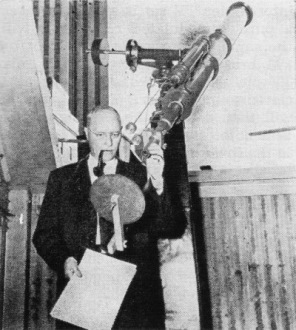Sunspots Aid Radio Signals |
|
Sunspot cycles repeat approximately every 11 years, so there had only been six solar maximums from the beginning of long distance radio communications (Marconi in 1901) up until this article was published in 1957. That year ('57) had the sun experiencing an extremely high number of sunspots (see chart below), as had the previous few years, which caused communications to be profoundly affected during the period. Under ideal conditions, high energy electrons typically ejected from the sun (coronal mass ejection, CME) cause the Earth's ionosphere to become an excellent reflector of RF energy at certain wavelengths, resulting in phenomenal long distance contacts. Under the worst conditions, extreme levels of "noise" are injected into radio signals, thereby severely degrading or even eliminating communications. This story reports on a comprehensive study on the effect of such activity on long distance communications, ultimately disproving the claims of many that no good ever comes of solar flare activity. Fortunately - or not according to this article from Radio & TV News - for Marconi, sunspot activity was at a minimum when he made his first successful transatlantic transmission in 1901. Sunspots Aid Radio Signals Radio weather forecasts improve the reliability of overseas circuits. Results of a 10-year study of solar radio disturbances released recently by John H. Nelson, of RCA Communications, Inc., relegated to the scrap-heap the popular belief that sunspots are always bad for overseas radio communications. Of course, severe sunspot activity can cause sudden ionospheric disturbances that may result in poor or no signals, but by knowing in advance possible sunspot activity, it is possible to maintain reliable service. This usually involves an increase in operating frequency to prevent signal loss. At the same time it is possible to even reduce operating power. Radio hams and TV DX-er's have long known that during periods of peak sunspot activity, such as exists at the present time, some very long distance contacts may be made. RCA Communications is taking advantage of this knowledge, coupled with Mr. Nelson's observations and forecasts, to maintain reliable radio contact with its overseas stations. Ordinarily, the bulk of such traffic is carried on 13 or 14 mc. or lower. When Mr. Nelson gives the word, the frequencies are shifted upward to 18 to 24 mc. The National Bureau of Standards also supplies, over station WWV, a continuous forecast of ionospheric conditions. These forecasts, however, are only for some 6 hours in advance while the forecasts used by RCA are for 30 hours in advance. These latter forecasts are also unique in that they take into account the positions of the various planets since Mr. Nelson believes these have an influence on radio conditions.
Posted June 22, 2021 |
|


